Fan Yu
SlotPi: Physics-informed Object-centric Reasoning Models
Jun 12, 2025Abstract:Understanding and reasoning about dynamics governed by physical laws through visual observation, akin to human capabilities in the real world, poses significant challenges. Currently, object-centric dynamic simulation methods, which emulate human behavior, have achieved notable progress but overlook two critical aspects: 1) the integration of physical knowledge into models. Humans gain physical insights by observing the world and apply this knowledge to accurately reason about various dynamic scenarios; 2) the validation of model adaptability across diverse scenarios. Real-world dynamics, especially those involving fluids and objects, demand models that not only capture object interactions but also simulate fluid flow characteristics. To address these gaps, we introduce SlotPi, a slot-based physics-informed object-centric reasoning model. SlotPi integrates a physical module based on Hamiltonian principles with a spatio-temporal prediction module for dynamic forecasting. Our experiments highlight the model's strengths in tasks such as prediction and Visual Question Answering (VQA) on benchmark and fluid datasets. Furthermore, we have created a real-world dataset encompassing object interactions, fluid dynamics, and fluid-object interactions, on which we validated our model's capabilities. The model's robust performance across all datasets underscores its strong adaptability, laying a foundation for developing more advanced world models.
CosyVoice 3: Towards In-the-wild Speech Generation via Scaling-up and Post-training
May 23, 2025Abstract:In our prior works, we introduced a scalable streaming speech synthesis model, CosyVoice 2, which integrates a large language model (LLM) and a chunk-aware flow matching (FM) model, and achieves low-latency bi-streaming speech synthesis and human-parity quality. Despite these advancements, CosyVoice 2 exhibits limitations in language coverage, domain diversity, data volume, text formats, and post-training techniques. In this paper, we present CosyVoice 3, an improved model designed for zero-shot multilingual speech synthesis in the wild, surpassing its predecessor in content consistency, speaker similarity, and prosody naturalness. Key features of CosyVoice 3 include: 1) A novel speech tokenizer to improve prosody naturalness, developed via supervised multi-task training, including automatic speech recognition, speech emotion recognition, language identification, audio event detection, and speaker analysis. 2) A new differentiable reward model for post-training applicable not only to CosyVoice 3 but also to other LLM-based speech synthesis models. 3) Dataset Size Scaling: Training data is expanded from ten thousand hours to one million hours, encompassing 9 languages and 18 Chinese dialects across various domains and text formats. 4) Model Size Scaling: Model parameters are increased from 0.5 billion to 1.5 billion, resulting in enhanced performance on our multilingual benchmark due to the larger model capacity. These advancements contribute significantly to the progress of speech synthesis in the wild. We encourage readers to listen to the demo at https://funaudiollm.github.io/cosyvoice3.
EmoVoice: LLM-based Emotional Text-To-Speech Model with Freestyle Text Prompting
Apr 22, 2025Abstract:Human speech goes beyond the mere transfer of information; it is a profound exchange of emotions and a connection between individuals. While Text-to-Speech (TTS) models have made huge progress, they still face challenges in controlling the emotional expression in the generated speech. In this work, we propose EmoVoice, a novel emotion-controllable TTS model that exploits large language models (LLMs) to enable fine-grained freestyle natural language emotion control, and a phoneme boost variant design that makes the model output phoneme tokens and audio tokens in parallel to enhance content consistency, inspired by chain-of-thought (CoT) and chain-of-modality (CoM) techniques. Besides, we introduce EmoVoice-DB, a high-quality 40-hour English emotion dataset featuring expressive speech and fine-grained emotion labels with natural language descriptions. EmoVoice achieves state-of-the-art performance on the English EmoVoice-DB test set using only synthetic training data, and on the Chinese Secap test set using our in-house data. We further investigate the reliability of existing emotion evaluation metrics and their alignment with human perceptual preferences, and explore using SOTA multimodal LLMs GPT-4o-audio and Gemini to assess emotional speech. Demo samples are available at https://yanghaha0908.github.io/EmoVoice/. Dataset, code, and checkpoints will be released.
Accurate Expert Predictions in MoE Inference via Cross-Layer Gate
Feb 17, 2025



Abstract:Large Language Models (LLMs) have demonstrated impressive performance across various tasks, and their application in edge scenarios has attracted significant attention. However, sparse-activated Mixture-of-Experts (MoE) models, which are well suited for edge scenarios, have received relatively little attention due to their high memory demands. Offload-based methods have been proposed to address this challenge, but they face difficulties with expert prediction. Inaccurate expert predictions can result in prolonged inference delays. To promote the application of MoE models in edge scenarios, we propose Fate, an offloading system designed for MoE models to enable efficient inference in resource-constrained environments. The key insight behind Fate is that gate inputs from adjacent layers can be effectively used for expert prefetching, achieving high prediction accuracy without additional GPU overhead. Furthermore, Fate employs a shallow-favoring expert caching strategy that increases the expert hit rate to 99\%. Additionally, Fate integrates tailored quantization strategies for cache optimization and IO efficiency. Experimental results show that, compared to Load on Demand and Expert Activation Path-based method, Fate achieves up to 4.5x and 1.9x speedups in prefill speed and up to 4.1x and 2.2x speedups in decoding speed, respectively, while maintaining inference quality. Moreover, Fate's performance improvements are scalable across different memory budgets.
Klotski: Efficient Mixture-of-Expert Inference via Expert-Aware Multi-Batch Pipeline
Feb 09, 2025Abstract:Mixture of Experts (MoE), with its distinctive sparse structure, enables the scaling of language models up to trillions of parameters without significantly increasing computational costs. However, the substantial parameter size presents a challenge for inference, as the expansion in GPU memory cannot keep pace with the growth in parameters. Although offloading techniques utilise memory from the CPU and disk and parallelise the I/O and computation for efficiency, the computation for each expert in MoE models is often less than the I/O, resulting in numerous bubbles in the pipeline. Therefore, we propose Klotski, an efficient MoE inference engine that significantly reduces pipeline bubbles through a novel expert-aware multi-batch pipeline paradigm. The proposed paradigm uses batch processing to extend the computation time of the current layer to overlap with the loading time of the next layer. Although this idea has been effectively applied to dense models, more batches may activate more experts in the MoE, leading to longer loading times and more bubbles. Thus, unlike traditional approaches, we balance computation and I/O time and minimise bubbles by orchestrating their inference orders based on their heterogeneous computation and I/O requirements and activation patterns under different batch numbers. Moreover, to adapt to different hardware environments and models, we design a constraint-sensitive I/O-compute planner and a correlation-aware expert prefetcher for a schedule that minimises pipeline bubbles. Experimental results demonstrate that Klotski achieves a superior throughput-latency trade-off compared to state-of-the-art techniques, with throughput improvements of up to 85.12x.
MinMo: A Multimodal Large Language Model for Seamless Voice Interaction
Jan 10, 2025



Abstract:Recent advancements in large language models (LLMs) and multimodal speech-text models have laid the groundwork for seamless voice interactions, enabling real-time, natural, and human-like conversations. Previous models for voice interactions are categorized as native and aligned. Native models integrate speech and text processing in one framework but struggle with issues like differing sequence lengths and insufficient pre-training. Aligned models maintain text LLM capabilities but are often limited by small datasets and a narrow focus on speech tasks. In this work, we introduce MinMo, a Multimodal Large Language Model with approximately 8B parameters for seamless voice interaction. We address the main limitations of prior aligned multimodal models. We train MinMo through multiple stages of speech-to-text alignment, text-to-speech alignment, speech-to-speech alignment, and duplex interaction alignment, on 1.4 million hours of diverse speech data and a broad range of speech tasks. After the multi-stage training, MinMo achieves state-of-the-art performance across various benchmarks for voice comprehension and generation while maintaining the capabilities of text LLMs, and also facilitates full-duplex conversation, that is, simultaneous two-way communication between the user and the system. Moreover, we propose a novel and simple voice decoder that outperforms prior models in voice generation. The enhanced instruction-following capabilities of MinMo supports controlling speech generation based on user instructions, with various nuances including emotions, dialects, and speaking rates, and mimicking specific voices. For MinMo, the speech-to-text latency is approximately 100ms, full-duplex latency is approximately 600ms in theory and 800ms in practice. The MinMo project web page is https://funaudiollm.github.io/minmo, and the code and models will be released soon.
CosyVoice 2: Scalable Streaming Speech Synthesis with Large Language Models
Dec 13, 2024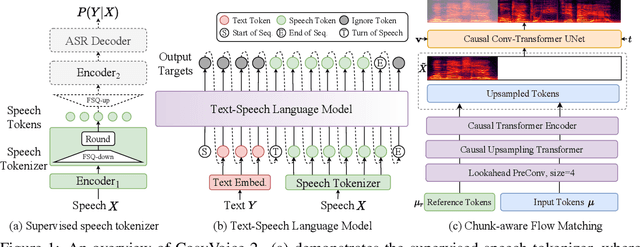

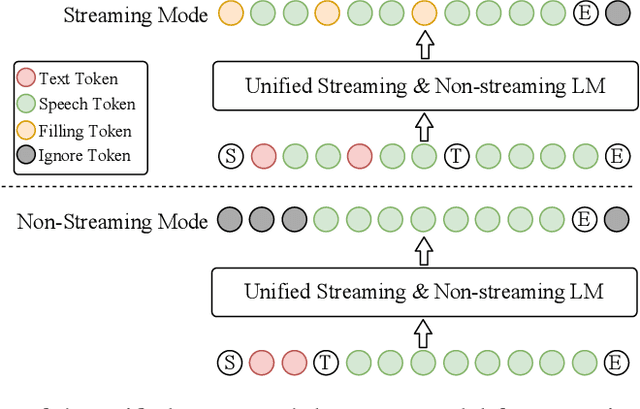

Abstract:In our previous work, we introduced CosyVoice, a multilingual speech synthesis model based on supervised discrete speech tokens. By employing progressive semantic decoding with two popular generative models, language models (LMs) and Flow Matching, CosyVoice demonstrated high prosody naturalness, content consistency, and speaker similarity in speech in-context learning. Recently, significant progress has been made in multi-modal large language models (LLMs), where the response latency and real-time factor of speech synthesis play a crucial role in the interactive experience. Therefore, in this report, we present an improved streaming speech synthesis model, CosyVoice 2, which incorporates comprehensive and systematic optimizations. Specifically, we introduce finite-scalar quantization to improve the codebook utilization of speech tokens. For the text-speech LM, we streamline the model architecture to allow direct use of a pre-trained LLM as the backbone. In addition, we develop a chunk-aware causal flow matching model to support various synthesis scenarios, enabling both streaming and non-streaming synthesis within a single model. By training on a large-scale multilingual dataset, CosyVoice 2 achieves human-parity naturalness, minimal response latency, and virtually lossless synthesis quality in the streaming mode. We invite readers to listen to the demos at https://funaudiollm.github.io/cosyvoice2.
ChatTracker: Enhancing Visual Tracking Performance via Chatting with Multimodal Large Language Model
Nov 04, 2024



Abstract:Visual object tracking aims to locate a targeted object in a video sequence based on an initial bounding box. Recently, Vision-Language~(VL) trackers have proposed to utilize additional natural language descriptions to enhance versatility in various applications. However, VL trackers are still inferior to State-of-The-Art (SoTA) visual trackers in terms of tracking performance. We found that this inferiority primarily results from their heavy reliance on manual textual annotations, which include the frequent provision of ambiguous language descriptions. In this paper, we propose ChatTracker to leverage the wealth of world knowledge in the Multimodal Large Language Model (MLLM) to generate high-quality language descriptions and enhance tracking performance. To this end, we propose a novel reflection-based prompt optimization module to iteratively refine the ambiguous and inaccurate descriptions of the target with tracking feedback. To further utilize semantic information produced by MLLM, a simple yet effective VL tracking framework is proposed and can be easily integrated as a plug-and-play module to boost the performance of both VL and visual trackers. Experimental results show that our proposed ChatTracker achieves a performance comparable to existing methods.
Enhancing Low-Resource ASR through Versatile TTS: Bridging the Data Gap
Oct 22, 2024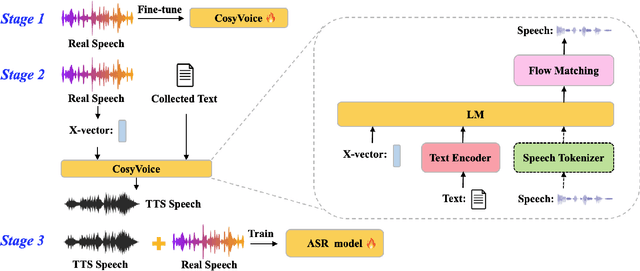
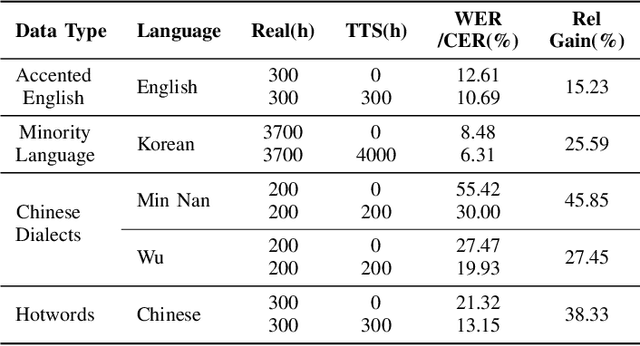

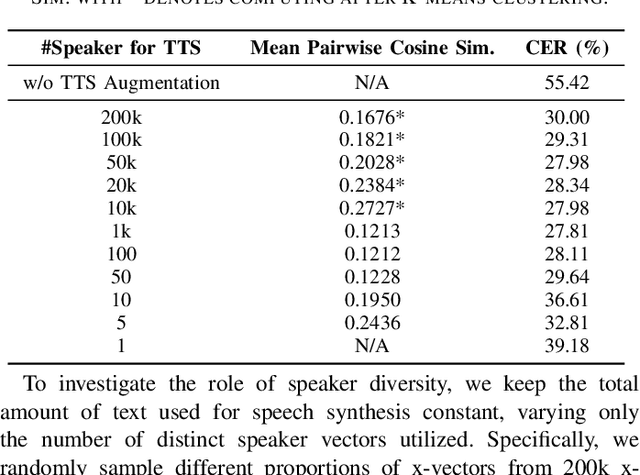
Abstract:While automatic speech recognition (ASR) systems have achieved remarkable performance with large-scale datasets, their efficacy remains inadequate in low-resource settings, encompassing dialects, accents, minority languages, and long-tail hotwords, domains with significant practical relevance. With the advent of versatile and powerful text-to-speech (TTS) models, capable of generating speech with human-level naturalness, expressiveness, and diverse speaker profiles, leveraging TTS for ASR data augmentation provides a cost-effective and practical approach to enhancing ASR performance. Comprehensive experiments on an unprecedentedly rich variety of low-resource datasets demonstrate consistent and substantial performance improvements, proving that the proposed method of enhancing low-resource ASR through a versatile TTS model is highly effective and has broad application prospects. Furthermore, we delve deeper into key characteristics of synthesized speech data that contribute to ASR improvement, examining factors such as text diversity, speaker diversity, and the volume of synthesized data, with text diversity being studied for the first time in this work. We hope our findings provide helpful guidance and reference for the practical application of TTS-based data augmentation and push the advancement of low-resource ASR one step further.
SEFraud: Graph-based Self-Explainable Fraud Detection via Interpretative Mask Learning
Jun 17, 2024



Abstract:Graph-based fraud detection has widespread application in modern industry scenarios, such as spam review and malicious account detection. While considerable efforts have been devoted to designing adequate fraud detectors, the interpretability of their results has often been overlooked. Previous works have attempted to generate explanations for specific instances using post-hoc explaining methods such as a GNNExplainer. However, post-hoc explanations can not facilitate the model predictions and the computational cost of these methods cannot meet practical requirements, thus limiting their application in real-world scenarios. To address these issues, we propose SEFraud, a novel graph-based self-explainable fraud detection framework that simultaneously tackles fraud detection and result in interpretability. Concretely, SEFraud first leverages customized heterogeneous graph transformer networks with learnable feature masks and edge masks to learn expressive representations from the informative heterogeneously typed transactions. A new triplet loss is further designed to enhance the performance of mask learning. Empirical results on various datasets demonstrate the effectiveness of SEFraud as it shows considerable advantages in both the fraud detection performance and interpretability of prediction results. Moreover, SEFraud has been deployed and offers explainable fraud detection service for the largest bank in China, Industrial and Commercial Bank of China Limited (ICBC). Results collected from the production environment of ICBC show that SEFraud can provide accurate detection results and comprehensive explanations that align with the expert business understanding, confirming its efficiency and applicability in large-scale online services.
 Add to Chrome
Add to Chrome Add to Firefox
Add to Firefox Add to Edge
Add to Edge